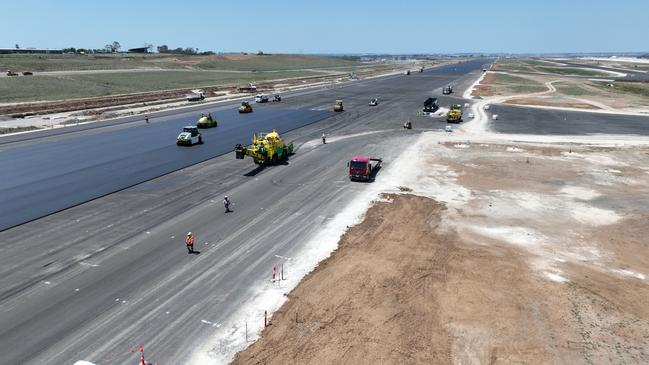Why air traffic controllers will have no window to look out of at Western Sydney Airport
When Western Sydney Airport opens in 2026 it will be missing a feature every other controlled airfield in Australia has.
Business
Don't miss out on the headlines from Business. Followed categories will be added to My News.
When Western Sydney International Airport opens in 2026, it will be missing something that every other airport in controlled airspace has – an air traffic control tower.
For the first time in Australia, Airservices will use a completely digitised system to control traffic in and out of Western Sydney, in a plan “cautiously” welcomed by air traffic controllers.
Civil Air president Tom McRobert said there were some good safety features in digitalised towers, including high resolution “pan, tilt and zoom” cameras providing much better views than binoculars.
But there were also some concerns, related to cyber security and a lack of redundancy.
“If the cameras fail, we can’t see anything,” said Mr McRobert.
“In a normal tower, even if you lose all your electronics, you always have a handheld radio and a pencil, and of course a window, so the redundancy of the traditional tower does play on people’s minds.”
In a digital tower situation, air traffic controllers are located off the airport site, in “a dark room with monitors”.
“They’ll be looking at an elaborate array of a 140 degree curved monitor set up, with the same system as we currently use for all the flight plans and controlling the aeroplanes,” Mr McRobert said.
“All the data is essentially the same, it’s just they won’t be looking out a window, they’ll be looking at a computer screen.”
To work around the threat of cyber attacks, the digital tower system would ideally be closed circuit and secure — but that aspect of the technology was yet to be determined.
At London City Airport, where a digital tower was used for air traffic control, systems were hardwired to avoid the risk of hacking.
“Western Sydney is planning to have (the operation) in a data centre at Eastern Creek, so the cameras will have to be streamed to somewhere nearby which does introduce a security aspect,” said Mr McRobert.

Airservices pointed out digital towers were also in use at several other locations throughout the world, including Argentina, Germany, Sweden, Norway and Denmark.
However larger more complex airports were steering clear, including Dubai and new Chinese airports.
“There’s a lot of challenges in putting in the technology. We’re not necessarily against it but there’s a long way to go for the technology to prove itself as the best way to do things,” said Mr McRobert.
Airservices Australia CEO Jason Harfield said the technology was “world class” and it would improve the capability of controllers.
“The Digital Aerodrome Service will enable us to deliver even greater levels of safety and increased capacity,” Mr Harfield said.
Western Sydney Airport CEO Simon Hickey added that the technology was “tried, tested and proven”.
“This exciting technology has earned its place in what will be an airport focused on delivering passengers and airlines an incredible experience,” he said.
Airservices planned to recruit 70 people including controllers and aviation firefighters for its Western Sydney Airport operations.
Mr McRobert said the digitisation of the tower would not alleviate the problem of staff shortages initially, but in the long term fewer controllers may be needed.
“One plan is if they can put all of these digital towers together and move them to a central location they would need less staff, but there’s a lot of hurdles with doing that,” he said.
“They tried it in the islands in the northern part of the UK, and ironically none of the air traffic controllers wanted to leave their little islands, so there were bigger issues than the technology itself.”
More Coverage
Originally published as Why air traffic controllers will have no window to look out of at Western Sydney Airport





